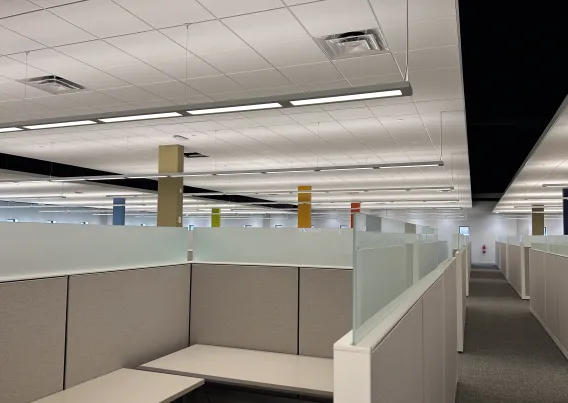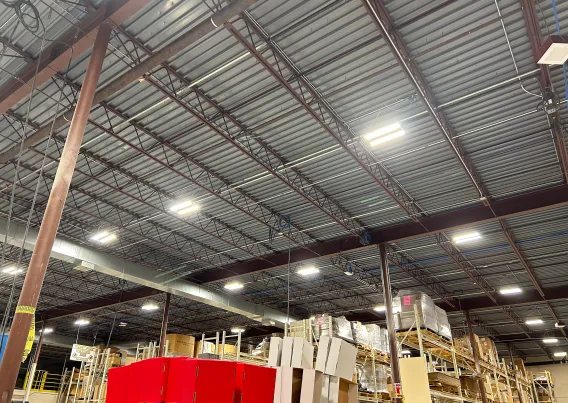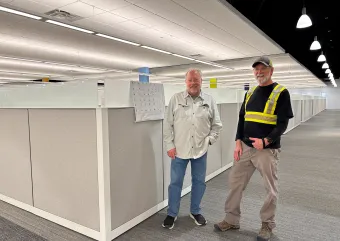Case Study: Upgrading commercial lighting with luminaire-level lighting controls
BI WORLDWIDE, a Minnesota-based marketing and engagement firm, set out to reduce energy consumption at their Minneapolis headquarters as part of their corporate sustainability efforts. After installing solar panels on one building within their complex, the team aimed to expand their green efforts. So, when it came time to upgrade an outdated fluorescent lighting they turned to luminaire-level lighting controls (LLLCs).
LLLCs are a proven technology comprising individually programmable luminaires that contain embedded sensors and compact control components, allowing each fixture to respond to occupancy, daylight, high-end trim, and even more opportunities for building operators.
| Project Name | Location | Primary Objective |
|---|---|---|
| BI Wordwide | Edina, MN | Maximize energy savings and maximize utility rebates to offset increment equipment costs. |
Getting Started
The project took place in a 72,300 square foot single-story building with a mezzanine, containing warehouse and office space. The warehouse includes shelving aisles of goods, while the office area featured primarily open workstations along with conference rooms, small phone rooms, a lunchroom, and a few private offices.
A consultant from Center for Energy and Environment’s One- Stop Efficiency Shop (One-Stop) assessed the existing lighting system, which consisted of outdated fluorescent fixtures lacking controls and causing harsh glare in some areas. To address these issues and achieve greater energy efficiency, the consultant recommended upgrading to an LLLC system, tailoring the controls to meet the needs of the different spaces and occupancy patterns.

The upgrade has been fantastic. The lighting is smooth and even, and it looks great aesthetically. It’s a noticeable improvement.
The Solution
BI WORLDWIDE worked with Preferred Electric, a local electrical contractor, and Davis Associates Inc., a local manufacturer representative agency, to select and implement the nLight Air system by Acuity Brands.
This system provides both illumination and advanced controls throughout the building, enabling LLLCs and non- LLLCs to be controlled together using a hybrid wireless and wired approach. The system consists of primarily of six fixture types, with 403 of the 544 luminaires installed were LLLCs, covering the entire warehouse area and most of the office space.
As part of a LLLC Initiative demonstration project, the LLLC team worked with BI WORLDWIDE’s team to monitor the system’s performance and verify energy savings by installing monitoring equipment to measure the energy consumption and control settings of the new lighting system. Based on the metering results, adjustments were made to the factory settings to refine both the high-end trim and occupancy settings.
The Results
Throughout the building, high-end trim of 20% was utilized to reduce unnecessary energy consumption without sacrificing occupants’ needs. Motion control was enabled with a default 10-minute timeout, later adjusted to 30 minutes during start up, and ultimately reduced to a 20-minute timeout. Overall, programming adjustments accounted for 54% savings in energy use after installation of the lighting system. As a result, this upgrade is estimated to achieve annual energy savings of 243,919 kWh compared to the previous lighting system, while also improving comfort with consistent, adaptive, and customizable lighting levels.
To offset a significant portion of the project cost, BI WORLDWIDE leveraged One-Stop’s rebate program and received an incentive of $71,907. In addition, BI WORLDWIDE expects to see first-year energy savings of $27,937.
This project demonstrates how businesses can achieve energy savings while improving functionality and occupant experience. By fine-tuning the LLLC system to meet building and occupant needs, the project achieved measurable energy reduction and demonstrated the value of collaboration during renovation projects.
This project is part of the growing effort by the LLLC Initiative to promote better lighting solutions that are both efficient and practical. By spotlighting real-world examples like BI WORLDWIDE, the LLLC Initiative encourages building owners and facility teams to feel confident installing LLLCs as a flexible, user-friendly system, not just for new builds, but also for existing buildings ready to take the next step beyond basic LEDs.

The availability of rebates was a significant factor in our decision. We were interested in moving forward, but the rebates really pushed us to commit.
Lessons Learned |
|---|
| 1. Supply chain delays: When selecting a system, ensure its availability aligns with the project schedule. |
| 2. Proper programming is key: Early collaboration for alignment on control settings is crucial to optimize performance. |
| 3. Maximize financial options: Leverage utility rebates to offset incremental costs. |
